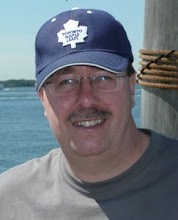Logged: 2.4 Hours
Fuel: 80 litres approx
We had an evening and a short morning in Toronto. In the evening we treated ourselves to a superb meal and fine wine at ‘The Keg’ (upmarket restaurant chain) in downtown Toronto. The next morning on checking the weather channel, it was calling for cloudy in the morning and rain in the afternoon. Rather than risk getting ‘stuck’ into Toronto by sticking with the original schedule, we decided to have a quick whip around the ‘Hockey Hall of Fame’ as early as we could then hot foot it over to the City Airport and make it out before midday.

This is how it turned out. I was a bit miffed that the Hockey Hall of Fame didn’t open until 0930, but there it is, we managed to have a look and buy a few souvenirs. We got the free ferry to the island and wandered around to the handling office. I did the flight planning with the equally wonderful Canadian equivalent of WX BRIEF, in this case 1-866-WX BRIEF. Got the weather, NOTAM’s and lodged a flight plan.
Dan headed out to the plane to untie it, pack it and do the A-check, while I settled up at the desk. Well, this was by far the most expensive of the whole trip, with handling and landing fees coming out at $CAN35 - about £18 - what I would pay for a single landing at Gloucester.
They were very helpful on reception and a talkative mechanic wandered by and told me that because of the airshow due that weekend (Canadian and USA Labor Day), there was a Spitfire in the hangar. Of course I just had to have a look on the way out.
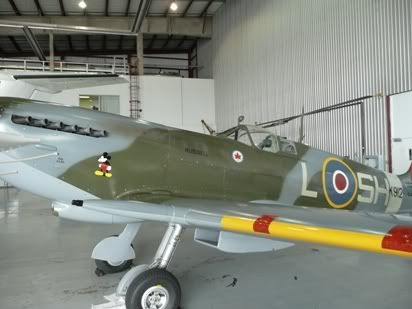
There was also a nice line-up of yellow Harvard trainers on the pan.
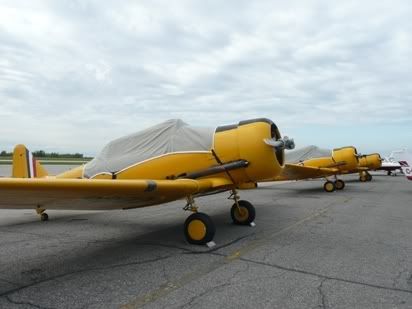
Dan had done a good job and I just checked the oil and fuel. Full to the gunnels, we mounted up and started up. I got the ATIS and called for taxi. Again we were given 08 as the active runway, but with a bit of a crosswind, though not much to write home about (one becomes very blasé about crosswinds in a nosewheel aircraft!).
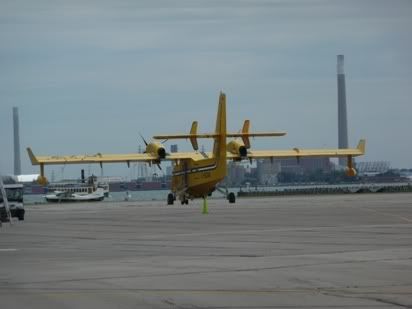
We lined up behind what looked like a Seneca twin and completed power checks. I called ready for departure in turn, but the tower cleared me to line up and jump ahead of the twin (who of course would take longer to do his checks).
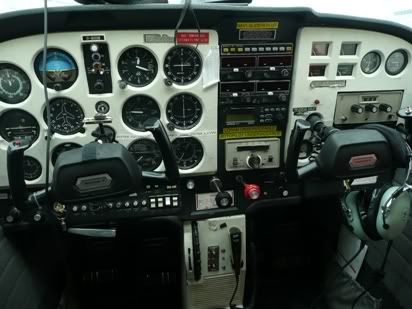
We lined up, powered up and were off. A straight ahead departure as we were already headed in the right direction. I was initially cleared to not above 1500’. I reported level attained and was directed to continue until past the chimneys not above 1500’ as there was a plane towing a glider above. Eventually we saw it as it headed the other way. The tower then cleared us to climb to 2500 and continue en-route.
I switched to Oshawa Tower and followed the Lake Ontario shoreline towards Oshawa. Once clear of Toronto controlled airspace, I climbed to 3500’ with a thin and high overcast at what I would estimate to be 6000’ – no bother at all!
I called Oshawa and advised them that I would be routing through their overhead
I wasn’t sure whether Canada had anything like the US ‘Flight Following’ so I resorted to the ‘UK Method’ of simply independently contacting each major airfield en-route for flight information service. Oshawa seemed busy enough with what sounded like circuit traffic so I called them and advised them out of courtesy that I would be routing through their overhead at 3500’. The weather seemed to be improving with the cloud becoming more broken, then scattered, then lovely bright sunshine with a handful of very scattered ‘good to be alive’ fair weather cumulus.
I stayed with Oshawa for a while, then switched to Trenton. I know that Trenton is a major Canadian Forces Base and that this is where many of the C130’s are based that fly everywhere, including to Alert near the North Pole. I had read up on their procedures and they seemed likely to route me either to the north or the south of the airfield via published VRP’s. Nevertheless, I called them at 30 miles and asked for a transit through their overhead, might as well try to get some nice photos. They gave me a squawk, but couldn’t see me. I called again at 15 miles and they now seemed to see me. They advised that I contact the tower. I asked again for a transit, but the tower routed me via the northern VRP and asked me to report north abeam the airfield at Frankford. Well of course Frankford wasn’t a published reporting point (why do airfields do that – publish VRP’s then not use them but use others that are not published). A quick scan of the map showed the town in question.
I reported at the point and was given another reporting point, this time Foxboro, again not a published VRP. The map showed it easily enough so well and good. At that point they gave me ‘contact en-route frequency’ (i.e. sod-off). So I ‘sodded off’ and tuned into Kingston on 122.50 on listening watch until we got a lot closer.
My original route had me routing north and inland of the town, but looking at the scenery and Lake Ontario and the St Lawrence River, I decided to head south of Kingston just over the water, so I could get some nice photos pointed north away from the glare of the sun. At 15 miles, I called Kingston Tower to advise them that I would route through their overhead at 3500’. They were very quiet and helpful, with one aircraft doing circuits.
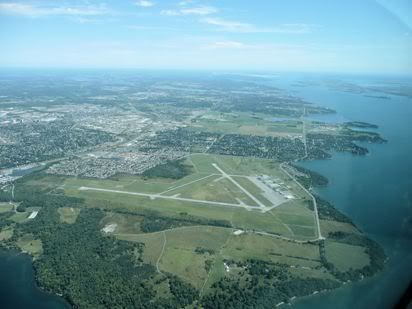
The views were excellent and Kingston looked like a really nice town from the air. We flew over the Royal Military College, set at the tip of a peninsula and over the old Fort Henry built in the 1830’s to protect the entrance to the Rideau Canal from those pesky Americans (who got a pasting from Canadian and British – OK mainly British troops - in the Canadian / US war of 1812).

We then routed north but parallel to the St Lawrence looking at the famous ‘thousand islands’ in the St Lawrence. We headed to Brockville, due south or Ottawa and changed to Ottawa Terminal on 127.70. The Ottawa frequency was very busy indeed and I was just about to give my call approaching Brockville when they called what sounded like a slightly wrong version of my callsign asking if it was ‘on frequency’. Given the various jumble of letters I was now used to hearing from US controllers for my callsign, I piped up and asked ‘C-GCOH was that for me’. Well, I guess it wasn’t, but she gave me a ‘C-GCOH pass you message’ anyway. So I ran through the usual format, stated inbound to land and requested joining instructions. She quickly gave me descend and maintain 2500’ and report Manotick. By now it was blazing sunshine with not a trace of cloud in the sky.
I confirmed this then set about asking Dan (who lives in Ottawa) where the hell Manotick was – again using a VRP that was not one of the five published VRP’s – why do people do this? Dan showed me on the map. Apparently a very classy town eight miles south of the airport on the Rideau River. We trundled along listening to a very busy frequency with the lady controller efficiently handling many flights in both English and French (yes, I know that mixed languages in the air is a very bad idea for situational awareness, but such is the ‘dual language’ political correctness prevalent in Canada).
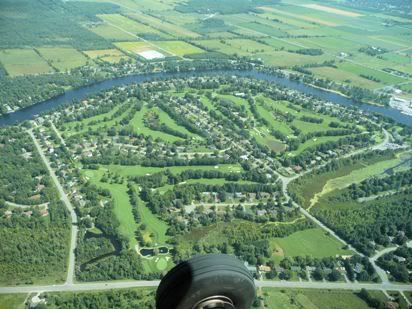
I called at Manotick and she told asked me to do a rate one right hand orbit to allow a commuter Embraer to cross in front coming into one of the main Ottawa commercial runways. I did this and Dan spotted the commuter half way around our turn. I called orbit complete and got a ‘continue’. At three miles she advised me that I was number two into 05 to an Cessna 152 doing circuits and that once I spotted him to slot in behind him.
Well I was still at 2500’, then Dan spotted the C152 which seemed to be doing pretty wide circuits. I did managed to slot in behind him, but now had to slow the plane down a lot and lose height fast. Throttle to idle, check speed, flaps to near full, some throttle back in and sideslip like hell! We were coming down fast now and while not gaining, still close-ish to the 152, but as they were doing circuits, we should be OK as they would be off and away as we were flaring.
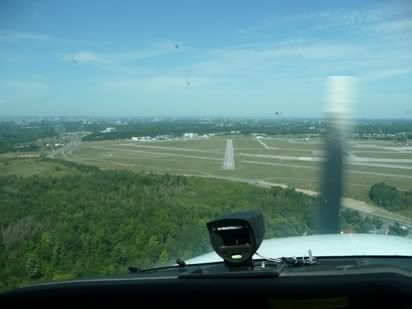
So I continued and had to keep full sideslip on until short final, where I unwound it for a normal short final approach. We flared, touched and rolled without use of brakes to the taxiway at the end of the runway to exit left and do the after landings.
We were down and back! I pulled in to parking and shut down. Dan bustled about efficiently unloading and doing the tie down while I completed the journey log and got my pilot stuff together.
We were down and back by 14:00ish. I wandered back to reception and had Agata help me complete their impressive computerised system while she worked out the fuel refunds I was due from the receipt (their policy is to still use their wet rate, but to give me credit for the amount of fuel I uploaded at their own Ottawa rates – so I would ‘suffer’ any higher rate per litre I paid elsewhere – fair enough I guess).
She told me the final figure and I meekly handed over my now battered Visa card and settled up. In parting, I confirmed with OFC that I would main on their system even though there was no cash credit on my account as I would want to rent from them in future. They seem to be a pretty good outfit, albeit with somewhat tired aircraft (aren’t they all) and very much a busy school, not so much a club. Of course I had to treat myself to an OFC branded polo shirt on the way out.
Well a good final leg to the trip, getting out ahead of the forecast rain which may have cost us a day. We had been remarkably lucky with the weather en-route, but Dan has always said (and I believe him) that the weather is far more stable and predictable in Canada and the US than in the UK.
